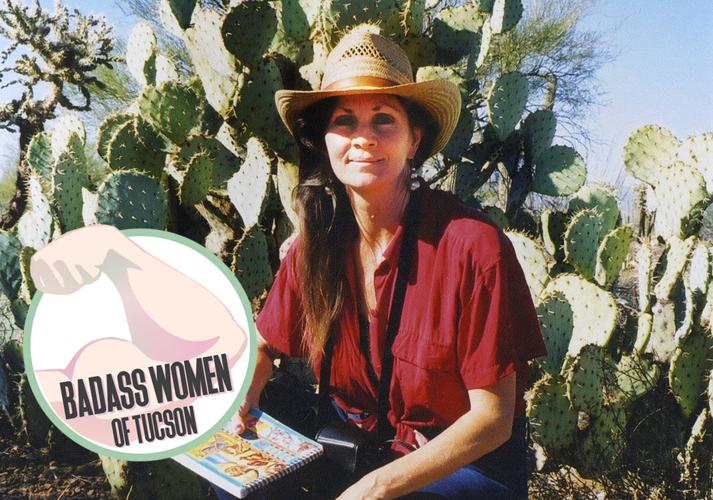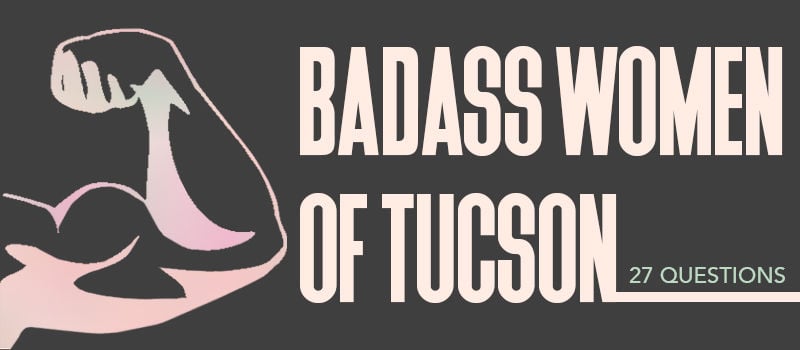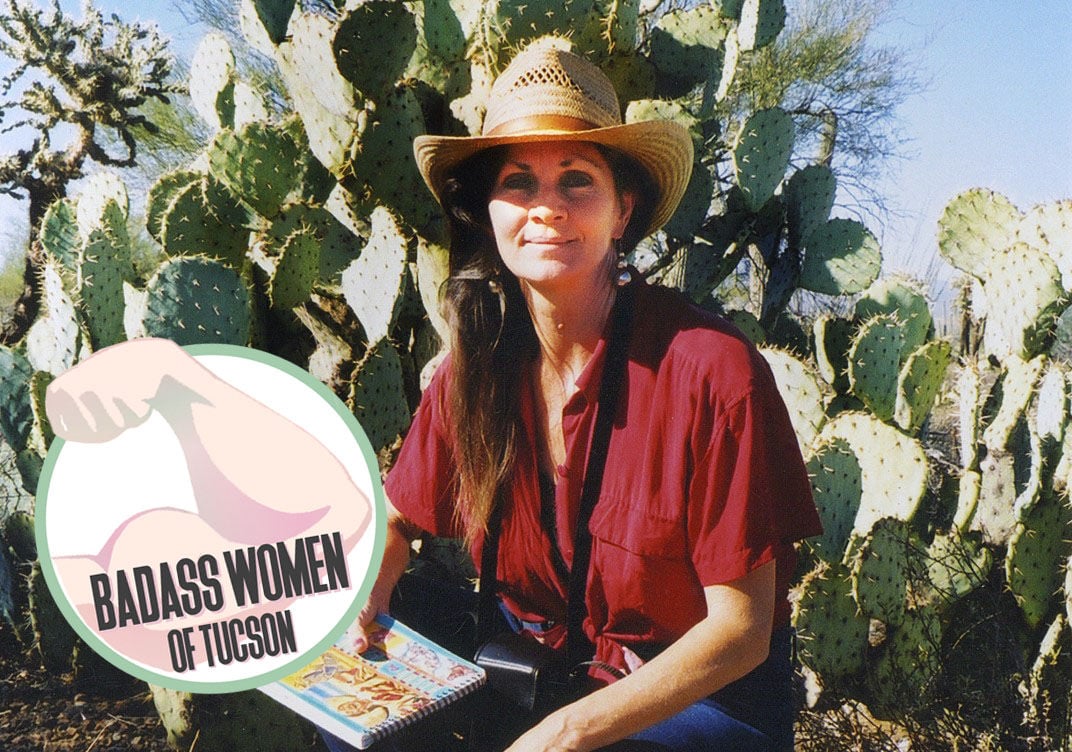Editor's note: Kathryn Ferguson died Sunday, April 9 after an unexpected cancer diagnosis last week. By the time of the diagnosis, the cancer had already spread, said friend and fellow dancer Michelle Morton. Morton has set up a GoFundMe page to help fund the medical — and now funeral expenses — in support of Ferguson's husband. She is survived by her husband, sister and nieces. Morton and others plan to put on a final dance show in Ferguson's honor. #ThisIsTucson first published this profile on Friday, February 24.
As a little girl growing up in Tucson, Kathryn Ferguson envisioned her future as a goat herder.
She would practice walking barefoot in the desert, outlining the rooms of her house with rocks, imagining a goat pen just there.
Although she let the goat-herding dream go (things like school and parents got in the way), she has remained tethered to the desert, the borderlands and the people. As a Tucson native, Ferguson grew up around both American and Mexican cultures. Her godparents were Mexican-American.
For the last 13 years, she has volunteered with the Tucson Samaritans, a humanitarian aid group dedicated to providing water, food and other emergency supplies to border crossers in distress. "Crossing with the Virgin: Stories from the Migrant Trail" chronicles the border experiences of Ferguson and other Samaritan volunteers.
Ferguson, now in her 60s, also has two documentaries on the region to her name: "The Unholy Tarahumara" and "Rita of the Sky."
Her 2015 book "The Haunting of the Mexican Border: A Woman's Journey" recounts the stories she has lived and the people she has loved on both sides of the U.S. - Mexico border.

Kathryn Ferguson's book, "The Haunting of the Mexican Border: A Woman's Journey," documents her experiences on the U.S.-Mexico border and how she has seen it change over time.
"It's a memoir, which I think is a very embarrassing word," Ferguson says. "I was so surprised it was a memoir but the University of Mexico (Press) categorized it that way. I thought it was just a nonfiction book about me in the desert with some other people."
After studying fine arts at the University of Arizona, Ferguson went to Spain to learn flamenco dance. She ended up in Morocco, where she discovered belly dancing, an art form that would take her around the world. Tucson was always home base, and for more than 40 years she has taught belly dancing classes out of her own studio, Xanadu Belly Dance Studio at 2408 N. Loretta Drive.
The experiences she had dancing the world nourished a passion for people and culture that she now channels toward immigration issues.
It's a delicate line to walk for Ferguson, who says she would rather transport medically compromised immigrants to a hospital than abide by the federal immigration law prohibiting the transportation of illegal immigrants.
"Because what am I going to do, sit there and let somebody die in front of me?" she says, though it hasn't been an issue yet. "Absolutely not."
About 10 years ago, two No More Deaths volunteers were arrested after they attempted to transport illegal immigrants to a medical clinic, according to Star archives. The charges were eventually dropped.
"You can provide them with food and aid because it's humanitarian assistance," says Bob Kee, a 12-year Tucson Samaritans volunteer. "You're not moving them along physically to another point. You're enabling them to stay alive. They're making the choice to go on or not, but we're not moving them in any way."
Standard procedure now is to call the U.S. Border Patrol or 911 in dire medical situations, Kee says.
"We encourage people, if they encounter someone in desperate need of water, medical attention or food and they have it, it's okay to provide it, but contact 911 or local law enforcement," says Daniel Hernandez, a public information officer for the Border Patrol's Tucson Sector. Volunteers still have to be careful not to "aid or abet" illegal immigrants as the law prohibits.
In her book, Ferguson recounts her own brushes with law enforcement, and in one instance writes that she was detained and then released by government officials after a chance encounter in the desert.
"The intensity of her passion and how that sense of the humanitarian element exists in doing this work, I think for her that's really paramount," Kee says.

Kathryn Ferguson explores the desert with Tucson Samaritans looking for border crossers who may need water and other emergency supplies.
And so she continues to trek dusty trails with backpacks full of water, hoping to prevent another death.
"When I go out, I'm looking for people," she says. "I'm looking to see their eyes."
This is what Ferguson had to say about the border, belly dancing and life as a badass.
Note: The interview has been edited for clarity.
Why she loves the border:
"It began in my childhood, because I have just been going back and forth across the border for my whole life, but of course, in childhood, you don't know it's going to be a big deal. We used to go across just to go grocery shopping. To buy chocolate and coffee. ... It was just part of my childhood, and it was always an occasion to look forward to, to go across the border into Mexico."
Wandering the desert as a Samaritan:
"Everyday we would go out and say in Spanish, 'Hello everybody, we're friends. We bring water and food. Don't be afraid.' And then bam! Somebody steps out onto the trail in front of you and you're just shocked every single time. You're out there looking, and you're calling, and you're still shocked when somebody is out there, one person, or a few people, in the middle of nowhere. You're just walking along and you're there with the cholla cactus and the trees, and then bam! There is this face that steps onto the trail in front of you, and it's always a surprise. It's a life-changer. What is some wonderful person doing in the middle of the desert looking all beat up? Why are they out there? There is no reason they should be out there."
Documentaries fueled her love for Mexico:
"I came back from North Africa ... and I was working at the PBS station in Tucson on the video crew ... I learned how to use cameras and white balances and all of that ... I was going down into Mexico's Sierra Madre ... and I met this man who is Rarámuri ... and I ended up going back and forth, still working at the PBS station. ... The documentary was about the changing world of the Tarahumara people. One guy, was who was governor of his village, couldn't wait to get rid of his traditions, and I thought this was interesting because another friend was very into the traditions. ... The other film is called 'Rita of the Sky' ... about a woman who had walked from Mexico to Kansas ... No one could speak to her because she only spoke 50 words of Spanish and the rest was her native language ... They put her in a mental hospital for 10 years and thought she was speaking the gibberish of a crazy person ... "

Kathryn Ferguson has made two documentaries about the people of Mexico.
How belly dancing fits in:
"Instead of studying flamenco dance for a few weeks in Spain, we ended up taking this drive to Morocco. The thing that got me was the music. We were in this place in Casablanca, and there were these five drummers playing instruments. ... I had this ballet background, and I was sitting there — you eat on the floor — and the musicians come out and it's like dynamite. And then this woman comes out dressed in lace, many colors, head to toe, lace up her neck, lace to her wrists ... She came to a table near me and picks up this round bread, and she ripped it off with her teeth, this piece of bread, and she just chewed in 6/8 rhythm ... I thought what's this? And all the sudden she is waving her hands and then she just starts to dance and picks up this tray with glasses of hot tea and puts this silver tray on her head and starts dancing ... I was just hooked. It was like something between some other culture and a circus, and this driving rhythm. It just took my breath away."
What she learned dancing around the world for nine years:

Kathryn Ferguson, pictured above, has been teaching belly dance out of her home studio for about 40 years.
"Everybody is the same. The Mexicans are the same as the Arabs as the Americans. The more I have been out around different cultures, the more I realize we are so much the same, and those things where we maintain our differences, that's like when you have a big dinner and you have olives and dates and all of this food on the table ... You have all of these cultures that are the same, that's us sitting down to eat, but everything you taste has a different taste."
Her father's gift:
"My father always encouraged me. My father used to say, 'You can do anything you want, especially you can do anything any man can do.' ... Other than love — he was so loving — that was the biggest gift I got from him ... It was never a thought that I couldn't go do something."
Doing it all as a woman:
"To see the world from a woman's point of view is like nothing else. It's fantastic. ... I think if you're a woman with a sense of humor, you're Annie Oakley. That's it in a nutshell, isn't it?"

Your name, age, occupation.
Kathryn Ferguson, author, dancer/choreographer, filmmaker.
I'm on a mission to _______________________.
Connect the dots between arts, people, and politics, and have fun along the way.
What's your astrology sign? Does it fit you?
Leo. Maybe it fits because I dream of following big cats in the wild.
Describe yourself in three words...
Feral, curious, instinctive.
And in five emojis.
😲😂🌹👄✋
Your first-ever job?
In middle school, I wrote a play starring my next-door neighbors, and I charged admission. We earned enough to buy a pie.
How long have you lived in Tucson?
I'm a native Tucsonan.
Who and/or what inspires you?
Pretty much everything. The wild. Animals. Color, paintings, words, sounds, laughter. My father who always made me laugh. Contradiction.
The secret to coping with stress is ________________.
Dance.
Your favorite Tucson spot?
The end of a dirt road where the trail begins.
What are your favorite three songs and why?
1. "Galician Flamenca" by Gino D'Auri who was a flamenco guitarist and a friend I loved. When I need to remember who I am, I go to this song. 2. "Mal Hombre" by Lydia Mendoza, about the eternal struggle between women and men. 3. "Kiko and the Lavender Moon" by Los Lobos. It is about a misfit who comes out at night to dance and dance.
Your go-to order at your favorite Tucson restaurant?
Kimoto Vol. 1, salmon sushi at Saga Sushi.
What's your favorite Tucson-only thing?
Saguaros and everything that lives near them.
You know you're a Tucsonan when _____________.
You stay in town during the summer because you love the heat.
What constitutes your morning getting-ready routine and how long does it take?
Coffee and more coffee for 15 minutes. Listen to the birds for as long as it takes. Throw on fantastic fabrics and earrings, 5 minutes.
Favorite app at the moment?
Give us a two-sentence pep talk.
Don't stop 'til you drop. Just one more little hill and you are there!
What would you tell your teenage self?
Don't fall in love yet.
What's a quality you got from your mama?
Love red dresses.
And one you hope to pass on to the next generation?
Find your passion.
The last great book you read?
Every five minutes it is a different book, but recently "H is for Hawk."
The last great movie you watched?
So many great movies but recently loved "Ixcanul," a movie made in Guatemala.
People would be surprised to hear you're actually a ______________ expert.
Mideastern dancer/choreographer, Egyptian style.
Is there something you've always wanted to learn, but haven't had the time?
Flamenco dance, photography.
Anything you've always wondered about Tucson?
What happens when the water leaves?
Favorite ice cream flavor?
Caramel.
Where can our readers follow you on social media?
thehauntingofthemexicanborder.com
Is there something you REALLY nerd out about?
Dogs, especially Airedales, Labradors, and Xoloitzcuintles.
What's your spirit animal?
Gila Monster.
Which fictional character (from TV, movies, books, etc.) just gets you?
Calamity Jane in the "Deadwood" TV series.
What makes you feel the most confident?
Connecting with someone while we laugh.
The best piece of advice you ever received?
Love more.










